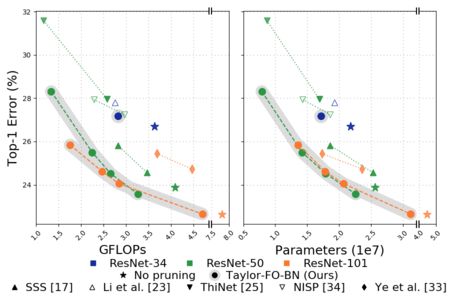Importance Estimation for Neural Network Pruning

Structural pruning of neural network parameters reduces computation, energy, and memory transfer costs during inference. We propose a novel method that estimates the contribution of a neuron (filter) to the final loss and iteratively removes those with smaller scores. We describe two variations of our method using the first and second-order Taylor expansions to approximate a filter's contribution. Both methods scale consistently across any network layer without requiring per-layer sensitivity analysis and can be applied to any kind of layer, including skip connections. For modern networks trained on ImageNet, we measured experimentally a high (>93%) correlation between the contribution computed by our methods and a reliable estimate of the true importance. Pruning with the proposed methods leads to an improvement over state-of-the-art in terms of accuracy, FLOPs, and parameter reduction. On ResNet-101, we achieve a 40% FLOPS reduction by removing 30% of the parameters, with a loss of 0.02% in the top-1 accuracy on ImageNet. Code is available at https://github.com/NVlabs/Taylor_pruning
Publication Date
Published in
Research Area
External Links
Copyright
This material is posted here with permission of the IEEE. Internal or personal use of this material is permitted. However, permission to reprint/republish this material for advertising or promotional purposes or for creating new collective works for resale or redistribution must be obtained from the IEEE by writing to pubs-permissions@ieee.org.
